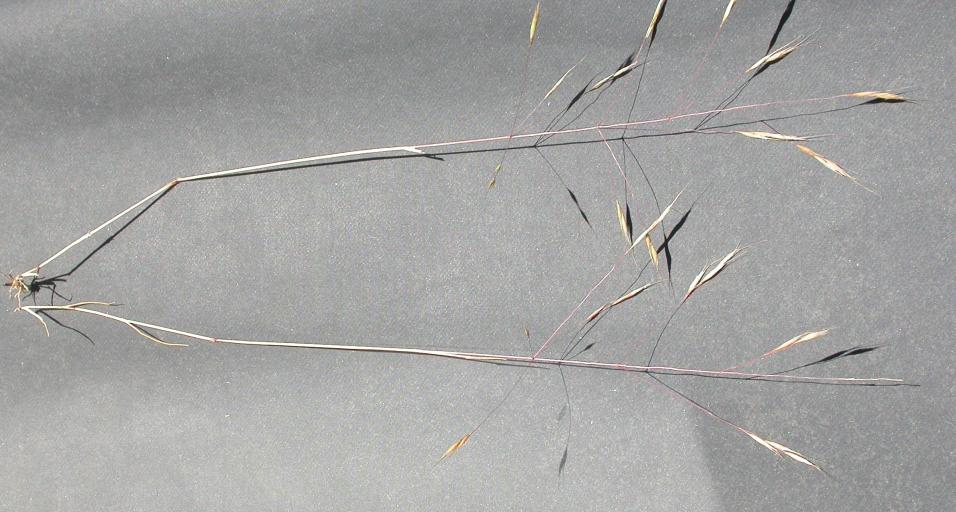This month’s “Invasive Plant of the Month” is Ventenata grass Ventenata dubia, (hereinafter “Ventenata”). This invasive is also known as wiregrass or North Africa grass and is an annual grass recently discovered in Wyoming. Ventenata is a cool season annual that is native to the Mediterranean. It was first found in North America in 1952. Since then, it has been reported in 10 states mostly in northwestern and northeastern portions of the country. Exact figures regarding acres affected by Ventenata infestations are not available, but where established, it is a fierce competitor with native grasses, reducing native rangeland forage production by 50% within a few years. Ventenata exhibits a high silca content making it highly unpalatable to livestock and wildlife.
Ventenata typically grows between 4 to 18 inches tall with slim erect culms (jointed hollow stems) covered in microscopic hairs which give the stem an appearance of smoothness. Seedlings are typified by lengthwise folded leaves which appear narrow. The seed head or inflorescence is an open panicle, resembling the mast of 18th century sailing ships. During the early part of the growing season, Ventenata appears silvery green, but quickly cures out to light yellow/tan color by the end of July/early August. Interestingly, Ventenata is slower growing than other invasive annual grasses found in Wyoming. Typically seed heads are formed a month later than invasive annual brome grasses (i.e. cheatgrass, Japanese brome). Ventenata has typically been found in North America from sea level to mid elevations in climates with moderate precipitation (14-44 inches/year). Ventenata typically prefers south facing hillsides with shallow, rocky, clay, or clay-loam soil types. It also appears to favor areas inundated with early season moisture that dry out as summer progresses.
Like other invasive annual grasses, Ventenata favors disturbed sites. Ground disturbing activities that remove herbaceous cover and expose bare mineral soil typically favor Ventenata germination. Heavy livestock grazing, construction, flooding, and wildfire can create conditions favorable to Ventenata germination. The best method for controlling the spread of Ventenata is prevention. Thoroughly cleaning equipment and clothes after visiting areas infested with Ventenata is extremely important in reducing seed dispersal to unaffected areas. In addition to limiting seed dispersal, keeping rangelands in healthy condition can also reduce the chance of Ventenata infestation. Grazing conservatively, controlling other invasive plant species, and limiting ground disturbance can help keep rangelands healthy and reduce the chance of Ventenata becoming established. If Ventenata does become established, it can be controlled with mechanical and/or chemical control methods. The most effective treatments appear to be a mixture of methods. Mechanical treatments (such as mowing) conducted prior to chemical treatment can greatly enhance the effectiveness of chemical treatments by removing above ground biomass. Herbicides that have shown success in con-
trolling Ventenata infestations include Imazapic (Plateau ®), rimsulfuron (Matrix ®), aminopyralid (Milestone ®) and glysophate (Round-up®).
Ventenata was recently discovered in Sheridan, Johnson, and Campbell Counties. This is the first documentation of this grass species in the state of Wyoming. Interestingly, this is also the first recorded case of this species in the Northern Great Plains ecosystem east of the Rocky Mountains. Prior to this discovery, Ventenata had only been documented in the northwest part, west of the Rocky Mountains. A task force has been formed, including local, state and federal agencies, to develop monitoring and action plans addressing this newly discovered outbreak.
--
By: Todd Caltrider, Wyoming Game and Fish Department Terrestrial Habitat Biologist
Photo by: Matt Lavin via Wikimedia Commons.
Invasive plant Ventenata recently discovered in Wyoming
Sara DiRienzo (307-777-4540)

